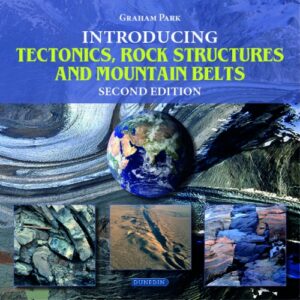By Graham Park

The second edition of this guide is written to explain the key concepts of tectonics and rock structures to students and to interested amateurs. I have reviewed a number of Graham Park’s books in recently years (see below) and he is clearly a prolific and excellent writer of books about the earth sciences. And I reviewed the first edition of this guide a while ago (see Introducing Tectonics, Rock Structures and Mountain Belts), in which I wrote:
Introducing Tectonics, Rock Structures and Mountain Belts is not an easy book to read. The illustrations are, as always, superb – colourful and clear – but this book is more suitable for the more mathematically and scientifically minded, especially those who enjoy the science of engineering. For instance (and inevitably), the first few chapters concern the detailed science of materials (fabrics) and forces, and this means that readers have to get their minds around some occasionally daunting scientific concepts … On the other hand, it is worth the effort.”
What I like about the theory of plate tectonics is that it is a unifying theory – like quantum physics/relativity (for physics) and the theory of evolution (for biology and medicine). It pulls together disparate smaller theories and ‘facts’ (notwithstanding, as Darwin rightly pointed out, you can’t have a fact without a theory) and explains them with a single, overarching system.
In this way, the application of plate tectonic theory has revolutionised structural geology by giving the study of rock structures a context in which they can be explained and understood. That is, if you can understand the large-scale movements of plates, you can understand smaller-scale structures, because the study of tectonics is the key to understanding things at a local level. For this reason, the guide introduces the reader to large-scale Earth structures and the theory of plate tectonics, before dealing with such things as deformation, stress and strain, faults and folds. It inevitably also covers such things igneous intrusions and volcanoes, mountain ranges (orogenic belts – both modern and ancient), and the structural effects of gravity.
Notwithstanding what I say above and the fact that the study and understanding of geological structures has usually been guided by the application of mathematics and physics, in this guide, the author avoids mathematical equations altogether and has reduced the geometry to an absolute minimum. And, like all Dunedin guides, it is compact and beautifully illustrated with colour photos and diagrams. The guide also contains a glossary of the more technical terms used (which are kept to a minimum) and a list of further reading for those who want to take the topic further.
And finally, as I said in a previous review of a Dunedin guide:
The nice thing about these guides is that the bite-sized nature of each chapter means you can dip in and out when you want to explore a particular subject; or you can sit down and read them in their entirety in only a few hours and feel that you really have learnt something by the time you have finished.”
Graham Park is Emeritus Professor of Tectonic Geology at the University of Keele.
Introducing Tectonics, Rock Structures and Mountain Belts, by Graham Park, Dunedin Academic Press, Edinburgh (2021), 192 pages (paperback), ISBN: 9781780460949.


